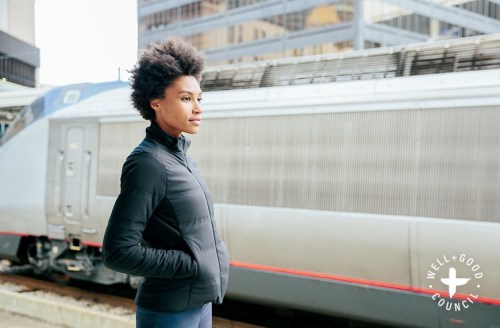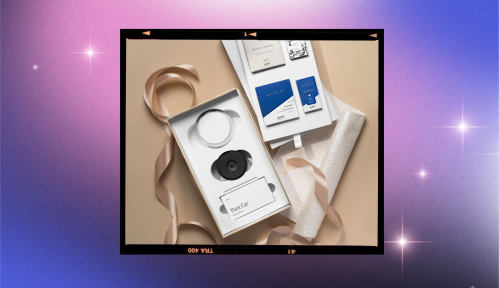The promise of connected, healing clothes is approaching “science fact.” They can heat and cool you, adapt to your movement, and help you sleep, moisturize your body all day, or instantly broadcast your mood. Well+Good Council member Susie Ellis, chairman and CEO of Global Wellness Summit previews the clothing of the future—and the game-changing garments that are already here.
Clothes are the only things pressed up against our bodies all day, but aside from broadcasting our style or just covering us up, they’ve been decidedly “dumb.” The promise of intelligent, connected clothing has been dangled for years, but too much of the technology was clunky, with all those awkward batteries, sensors, and wires. (Smart underwear doesn’t feel so smart if you can’t wash them.)
The tech tipping point finally feels here.
But the tech tipping point finally feels here. Sensors and power supplies are becoming seamlessly integrated into new fabrics, and with the interweaving of everything from AI to body-mapping technologies, it means the new connected clothes aren’t just smart, they’re intuitive. They can adapt to the environment and weather, your movement and body state—in real time. They can heat and cool your body, regulate airflow and UV rays, help us sleep and recover, change shape based on our movement, and shift color and pattern with our mood. In time, they will collect all kinds of biometric and behavioral data, and perhaps ultimately give people some extra-human powers.
New clothing lines are even suffused with more traditional “wellness”: like collagen and algae-immersed materials that moisturize your body all day or brands infused with Ayurvedic medicinal plants. If the old saying is, “Clothes make the man,” now a new breed of clothes can make the man (and woman) well.

Scientific breakthroughs are on a roll
Universities are rapidly cracking the code on how to make all these embedded sensors and conductive systems self-powering, radically less bulky, and able to stand up to the washing machine and iron. For instance:
- Scientists at the University of Massachusetts, Amherst have invented fabrics that harvest your own body heat to easily power “creatively miniature” biosensors, motion trackers and haptic feedback devices. These seamlessly powered (and hyper-complex) fabrics can monitor your heart rate, detect joint motion and sleep posture, track how fast or slow you’re breathing—and can take a beating and be washed.
- University of Maryland researchers just developed a revolutionary fabric that is the first to automatically warm or cool you off. When you’re hot, humid or sweating, the textile “opens the gate” to remove body heat; when cold and dry, the complex fabric “closes the gate” and keeps heat on your body.
Some “well fashion” is already out there
Shape-shifting Sneakers: Nike’s new Adapt BB sneaker is the first digitally connected shoe that doesn’t just track your activity, it alters its shape on the fly. It locks on tight to your foot when you need support and loosens up when you’re more relaxed. The Adapt platform is expected to make its way into all kinds of Nike apparel, meaning clothes that shape-shift with your movement and can feel your pain.
Perfect-Temp Jackets: Ministry of Supply’s new AI-powered, wirelessly-charged Mercury jacket (a brainchild of MIT engineers) automatically adjusts its temperature based on the weather, your body heat, and how much you’re moving. And since it’s app-powered, you can also say “Alexa, turn on my jacket” as you run out the door.
Far Infrared Healing: Under Armour’s latest smart clothes innovation, Rush, blends minerals into the fabric that capture body heat and then transmit that energy back as far infrared radiation. The idea is to dilate blood vessels and boost circulation and oxygen delivery to an athlete’s tissues—so they perform, recover, and sleep better. Lumiton’s new Wear Healthy line uses textiles that get energized by sunlight to produce red/near-infrared light with the aim of boosting collagen, stimulating muscle growth, and reducing pain.
Wearable skincare: Tech brand Buki has released the Collagen Collection, which embeds collagen into fabrics to provide all-day moisturization, and the effect never wears out because the fabric is made of the protein. Alga-Life, in creating radically eco-friendly clothes made from algae, nurtures your skin with natural seaweed compounds.

“Ancient wellness” wear: Beyond the super-futuristic, brands are weaving a little “ancient wellness” into collections. Australian label Kitx, menswear line Emily Bode, and Monsoon Bloom all infuse Ayurvedic medicinal herbs right into their clothes. And if we had Earth Shoes in the ’70s, designer Astara has essentially created “earthing shoes,” using various crystals so the shoes resonate at the same vibration as Earth’s magnetic field, and you feel like you’re barefoot.
Mood clothing: A new breed of clothing allows you to express yourself, undergoing magical transformations based on your mood or the environment. The University of Central Florida has created ChroMorphous, an app-powered fabric that lets you switch up your clothes’ color and pattern (pink plaid? blue stripes?). The Rainbow Winters line responds to forces like light, sound, speed, and moisture—think, a holographic leather dress that illuminates with sound/music. Kitty Yeung’s smart dresses might glow according to the wearer’s brain waves or have automated “flying” sleeves that can move on their own.
For centuries, humans haven’t thought much about how fashion impacts their well-being—or imagined the incredible ways that it could. But a new era where fashion, technology, and wellness become intertwined is here.
For more, read more of the Global Wellness Summit’s multifaceted “Well Fashion” trend here.
Susie Ellis is the chairwoman and CEO of the Global Wellness Institute. She is also chairman and CEO of the Global Wellness Summit. Recognized as one of the leading authorities on the multi-sector wellness industry, she is frequently cited in major global publications.
What should Susie write about next? Send your questions and suggestions to [email protected].
Sign up for the Well+Good SHOP Newsletter
Get exclusive deals on wellness, beauty, fitness, and food products that have been hand-picked by our editors.
Got it, you've been added to our email list.








